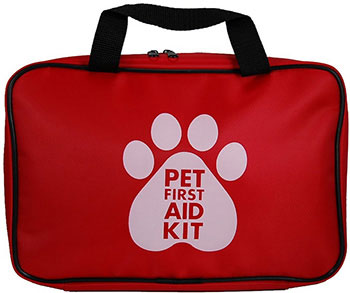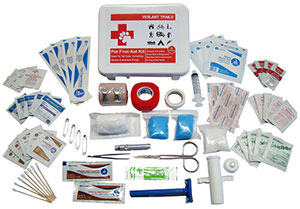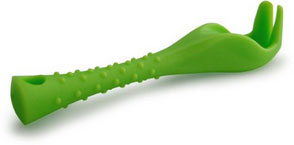Pet First Aid Kit
 When it comes to our pets, things can happen when you least expect it. Having a first aid kit handy is essential to help you quickly and effectively deal with minor cuts, as well as more serious situations. You may be on a walk or hike with your pup when they experience an injury, therefore it is a great idea to create two kits - both a home kit and a mobile version that you can carry in a backpack or keep in the car.
When it comes to our pets, things can happen when you least expect it. Having a first aid kit handy is essential to help you quickly and effectively deal with minor cuts, as well as more serious situations. You may be on a walk or hike with your pup when they experience an injury, therefore it is a great idea to create two kits - both a home kit and a mobile version that you can carry in a backpack or keep in the car.
Although self-administered emergency treatment for serious situations should never be considered a substitute for veterinary care, knowing how to respond quickly can save your pet from more pain and distress, and can also help save their life before you reach a veterinarian.
First, we'll talk about temperature and heart rate, and then go into building our own first aid kit. We will also go over important things to take into consideration if you live in rattlesnake country (including the rattlesnake vaccine option).
Common Pet Injuries
Pet injuries are inevitable, and knowing how to quickly and effectively help your pet can make all the difference in the world. After exploring the article below on building your own first aid kit, learn how to treat common pet health problems such as cuts, limping, stings, choking, poisoning, and other injuries.
Temperature & Heart Rate
Let's familiarize ourselves with a dog or cat's vital signs to have a baseline of what is normal and what is not:
| Heart Rate | Temperature | |||
| Puppies/Kittens | 60-220 BPM | 96-100° | ||
| Small Dogs (<30 lbs.) | 100-220 BPM | 100-102.5° | ||
| Dogs (>30 lbs.) | 60-160 BPM | 100-102.5° | ||
| Cats | 140-220 BPM | 100-102.5° | ||
Source: Clinical Textbook for Veterinary Technicians
Measuring the Heart Rate
For a dog or cat, feel for the heartbeat:
- Where the left elbow reaches the chest, place your hand on the chest.
- Halfway down the inner thigh where the leg meets the body.
- Below the ankle of either hind leg.
Hold your middle finger and index finger on the pulse point. Count how many beats or pulses you can hear during a 10-second period, and then multiply that by 6 to calculate the number of beats per minute.
Taking the Temperature
A dog or cat's temperature is taken rectally. Using a rectal or pediatric digital thermometer, lubricate the tip with petroleum jelly or vaseline. Keep your pet in a standing position if possible, and hold the tail up. Gently insert tip into their rectum and leave for the required time (usually a beep from the thermometer). Remove and read.
Building the First Aid Kit
You can either purchase a pet first aid kit online, or make your own. The benefit of purchasing a complete kit is that it often comes in a handy container. Let's take a look at what a good first aid kit should include.

- Scissors
- Rectal thermometer
- Eye dropper (to flush wounds)
- Large and small syringe
- Forceps or tweezers
- Gauze pads/non-stick pads, also known as "telfa pads" (2" and 4" square)
- Gauze roll (for wrapping wounds, and for muzzling an injured pet)
- Non-stick bandages (to control bleeding or protect wounds)
- Adhesive bandages (2" rolls for securing non-stick bandages and gauze)
- 3% hydrogen peroxide (to induce vomiting of poisonous substances)
- Vetericyn (safe and non-toxic for all pets, including reptiles, rodents, birds, and livestock)
- Milk of magnesia or activated charcoal (binds to poisonous substances, preventing them being absorbed in the bloodstream)
- Vetericyn
- Baking soda (for bee stings)
- Vaseline
 Tick Twister (to remove ticks)
Tick Twister (to remove ticks)- Set of booties (for hot concrete/tarmac on a hike or walk, or for an injured paw)
- Leash and muzzle (to prevent a dog irritating an injury or to help keep a dog calm)
- Large, clean towel or blanket (kept sealed/clean - can be used to stabilize during transport)
For extended trips or periods of time
- Medications your pet needs
Emergency phone numbers
- Your veterinarian's phone number
- Poison control centers:
- Pet Poison Helpline: (800) 213-6680, cost is $35/call
- ASPCA Poison Control Center: (888) 426-4435, cost is $65/call
Pet First Aid Courses
There are several organizations that offer pet first aid courses around the United States. They are often only 2-4 hours long and can be invaluable in helping you to respond to health emergencies, and provide basic first aid for the four-legged members of your family.
Examples of these organizations include:
If You Live In Rattlesnake Country

It is important to familiarize yourself with the vets in your area that carry antivenin. Not all vets do, and knowing where to head in the event of a rattlesnake bite can mean the difference between life and death.
If your dog is bitten by a rattler, it is always an emergency, even if your dog has had the rattlesnake vaccine. Bites by non-venomous snakes should also be looked at by a vet in case of infection.
RELATED ARTICLES
- Healthy & balanced pet diet
- Why pets are getting sicker
- Bones - nature's toothbrush
- Pet food recalls
- Fleas, ticks, & mosquitoes
- Natural dog grooming
- Pet dental care
- Pet vaccinations
- Declawing




